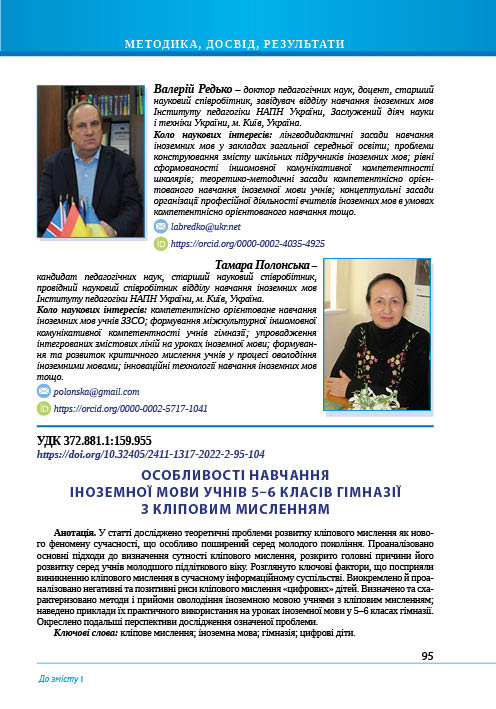Abstract
The article explores the theoretical problems of “clip thinking” as a new phenomenon of our time, which is especially common among the younger generation. The rapid development of the latest information technologies has led to the production of huge amounts of information, its accumulation and quick transfer. Clip thinking is a kind of response and protective reaction of a person to information and psychological overload. The basic approaches to determining the essence of clip thinking are analysed, the main reasons for its development among young adolescents are revealed. The progress of television and, especially, the Internet, has led to the fact that the current young generation is thinking less and less logically, ceases to delve into information, perceiving it superficially and fragmentarily. Experts argue that the clip type of thinking is primarily characteristic of Generation Z, that is young people who grew up under the influence of the digital revolution – “digital children”. There is no unambiguous definition of the phenomenon of “clip thinking”, but according to scientific sources we can conclude that nowadays the term “clip thinking” means features of thinking of modern young people living in a society of new high information technologies and are characterized by high speed of image perception, visuality, emotionality and associativity. The key factors that contributed to the emergence of clip thinking in the modern information society are considered. The negative and positive features of clip thinking of “digital” children are singled out and analysed. The author argues that clip thinking cannot be ignored or eliminated in people’s lives or in the educational process. On the contrary, its positive features should and can be used in teaching students of institution of general secondary education in any school subject, including a foreign language. Methods and techniques of mastering a foreign language by students with clip thinking are defined and characterized; samples of their practical use in foreign language lessons in grades 5–6 of the gymnasium are proposed. Further prospects for the study of this problem are outlined.
References
Про Концепцію Національної програми інформатизації. № 1089-IX (2020). https://zakon. rada.gov.ua/laws/show/75/98-%D0%B2%D1%80#Text
Концепція впровадження медіаосвіти в Україні (нова редакція). (2016). Найдьонова Л. А., Слюсаревський М. М. (Ред.). Інститут соціальної та політичної психології НАПН України. http://mediaosvita.org.ua/book/kontseptsiya-vprovadzhennya-mediaosvity/
Moles, A. A. (2019). Sociodynamique de la culture. De Gruyter Mouton. https://doi.org./10. 1515/9783111672403
Toffler, A. (1989). The third wave: The Classic Study of Tomorrow. Bantam; Reissue edition. https://ia801301.us.archive.org/26/items/The-Third-Wave_Toffler.pdf
McLuhan, M. (2011). The Gutenberg Galaxy: The Making of Typographic Man. New edition. University of Toronto Press. https://books.google.com.ua/books/about/The_Gutenberg_ Galaxy.html?id=VWspDwAAQBAJ&redir_esc=y
McLuhan, M. (2001). War and Peace in the Global Village. Gingko Press. https://gingkopress.com/shop/war-and-peace-in-the-global-village-new/
Удовицька, Т. А. (2013). «Кліпове мислення» молоді: особливості прояву у процесі навчання (до постановки проблеми). Вища освіта України: теорет. і наук.-метод. часопис. Вип. 31. Т. VIII (50). Інститут вищої освіти НАПН України. 407–416.
Rosen, L. D. (2007). Me, MySpace, and I: Parenting the Net Generation. Palgrave Macmillan.
Makarowska, O. (2020). Zwrot ku sieciowości w dyskursie glottodydaktycznym. roczniki humanistyczne. Tom LXVIII, zeszyt 10. S. 207–220. DOI: http://dx.doi.org/10.18290/rh20 6810–16.
Полонська, Т. К. (2020). Інтерактивні методи реалізації інтегрованих змістових ліній на
уроках іноземної мови у 5–6 класах гімназії. Іноземні мови в школах України. 4. 4–8.
Полонська, Т. К. (2022). Критичне мислення як технологія компетентнісно орієнтованого навчання іноземних мов учнів 5–6 класів гімназії. Український педагогічний журнал. 1. 70–79.
Pro Kontseptsiiu Natsionalnoi prohramy informatyzatsii. 1089-IX (2020). https://zakon.rada.gov. ua/laws/show/75/98-%D0%B2%D1%80#Text (in Ukrainian).
Kontseptsiia vprovadzhennia mediaosvity v Ukraini (nova redaktsiia). (2016). Naidonova L. A., Sliusarevskyi M. M. (Red.). Instytut sotsialnoi ta politychnoi psykholohii NAPN Ukrainy. http://mediaosvita.org.ua/book/kontseptsiya-vprovadzhennya-mediaosvity/ (in Ukrainian).
Moles, A. A. (2019). Sociodynamique de la culture. De Gruyter Mouton. https://doi.org./10. 1515/9783111672403. (in French).
Toffler, A. (1989). The third wave: The Classic Study of Tomorrow. Bantam; Reissue edition. https://ia801301.us.archive.org/26/items/The-Third-Wave_Toffler.pdf (in English).
McLuhan, M. (2011). The Gutenberg Galaxy: The Making of Typographic Man. New edition. University of Toronto Press. https://books.google.com.ua/books/about/The_Gutenberg_ Galaxy.html?id=VWspDwAAQBAJ&redir_esc=y (in English).
McLuhan, M. (2001). War and Peace in the Global Village. Gingko Press. https://gingkopress.com/shop/war-and-peace-in-the-global-village-new/ (in English).
Udovytska, T. A. (2013). «Klipove myslennia» molodi: osoblyvosti proiavu u protsesi navchannia (do postanovky problemy). Vyshcha osvita Ukrainy: teoret. i nauk.-metod. chasopys. Vyp. 31. T. VIII (50). Instytut vyshchoi osvity NAPN Ukrainy. 407–416. (in Ukrainian).
Rosen, L. D. (2007). Me, MySpace, and I: Parenting the Net Generation. Palgrave Macmillan. (in English).
Makarowska, O. (2020). Zwrot ku sieciowości w dyskursie glottodydaktycznym. roczniki humanistyczne. Tom LXVIII, zeszyt 10. 207–220. DOI: http://dx.doi.org/10.18290/rh20 6810–16. (in Polish).
Polonska, T. K. (2020). Interaktyvni metody realizatsii intehrovanykh zmistovykh linii na urokakh inozemnoi movy u 5–6 klasakh himnazii. Inozemni movy v shkolakh Ukrainy. 4. 4–8. (in Ukrainian).
Polonska, T. K. (2022). Krytychne myslennia yak tekhnolohiia kompetentnisno oriientovanoho navchannia inozemnykh mov uchniv 5–6 klasiv himnazii. Ukrainskyi pedahohichnyi zhurnal. 1. 70–79. (in Ukrainian).

This work is licensed under a Creative Commons Attribution-NonCommercial-ShareAlike 4.0 International License.


